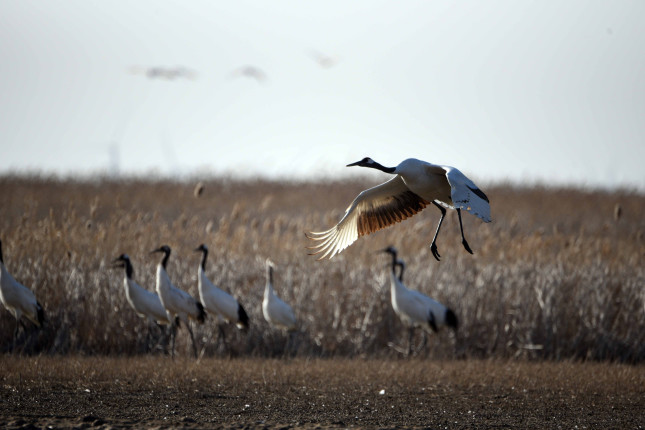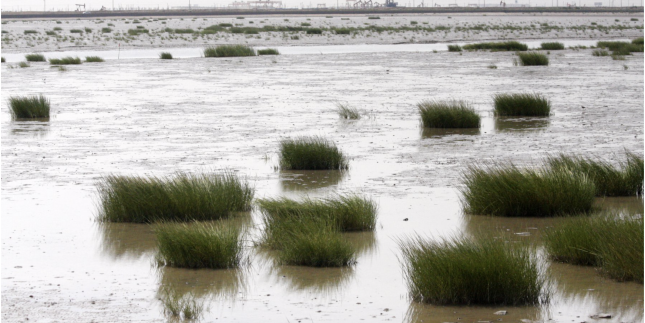-
Building Back China’s Great Wetland Wall: Q&A with Paulson Institute Wetland Team
September 21, 2023 By Zhiyuan ZhouKnown as “Earth’s kidneys,” wetlands provide a variety of ecological benefits: habitats for diverse species, flood containment, pollutant purification, and carbon absorption. But in China, wetland loss and degradation has exposed people to the whims of climate change. What has China done to protect its wetlands, and how should the country better adapt to climate change with wetlands—a “Great Wall” made of mudflats, mangroves, and waterbirds? Jianbin Shi and Xiaojing Gan, two China-based wetland experts from the Paulson Institute, may enlighten us.
Extreme rainfall and flooding tormented China this summer. In July, Typhoon Doksuri brought the heaviest rainfall to Beijing in 140 years, forcing more than 50,000 to evacuate. August flooding devastated some of China’s prime cropland. Nearly 40% of the Wuchang rice crop, a popular sticky rice grown in China’s northeast, was wiped out.
As questions emerge over whether Chinese cities and agriculture can adapt to climate-driven extreme weather, wetlands offer a promising resilient solution. Alongside rainforests and coral reefs, wetlands are one of the most productive ecosystems in the world at storing floodwaters, improving water quality, protecting wildlife, and sequestering carbon. Unfortunately, according to studies conducted by Paulson Institute, China lost 53% of its temperate coastal ecosystems, 73% of its mangrove forests, and 80% of its coral reefs in recent decades.
In the run up to hosting the 2022 Convention on Biodiversity negotiations and the Ramsar Convention on Wetlands, China’s efforts to protect wetlands reached an all-time high. Celebrating the 30th anniversary of China’s accession to the Ramsar Convention, the Chinese government added 18 sites to the Wetlands of International Importance list during negotiations. The country now boasts the fourth largest coverage of wetlands in the world. In the same year, China’s Wetland Protection Law was launched, a milestone in increasing protection of wetlands threatened by climate change and industrial development.
China’s recent policy actions are admirable, but still may not be enough. In 2016, only 24% of the country’s coastal wetlands—the so-called “blue carbon” reserves—were officially designated as protected areas. Although China rapidly expanded the number of protected wetlands in recent years, those wetlands that sit at the lower end of China’s three-tier wetland protection system–national, provincial, and general–are less likely to be properly managed. “China should do more to improve the health of each individual wetland,” said Dr. Shi Jianbin, Director of the Wetlands Conservation Program at the Paulson Institute.
The China Environment Forum sat down with Dr. Shi Jianbin and Dr. Gan Xiaojing, two experts in wetland conservation, to learn about their research and perspectives on how China could better safeguard its vulnerable wetlands.
China Environment Form (CEF): Why did Paulson choose to work on wetlands in China? How does Paulson collaborate with policymakers and activists?
Dr. Shi: Paulson began its first project Coastal Wetland Conservation and Management in China in 2015. Coastal wetlands are an integral component of blue carbon ecosystems, which sequester and store CO2 for long periods, sometimes thousands of years. Protecting wetlands is a nature-based climate solution, which means using natural features to promote ecosystem adaptation and resilience.
This project filled a gap, for in 2015 many Chinese NGOs focused on terrestrial life, rivers, and lakes with few working on coastal wetlands. Paulson initially partnered with the Bureau of Wetland Management under China’s National Forestry and Grassland Administration. We submitted our research results and policy recommendations to governments in coastal Tianjin, Hebei, and Jiangsu.
Today, we work closely with Chinese NGOs and universities. On our Mangrove Protection and Restoration Strategy project, Paulson has collaborated with the Shenzhen Mangrove Conservation Foundation and Xiamen University. We aim to identify challenges protecting mangroves and formulate policy recommendations.
We also have created a platform to involve more organizations in wetland protection with our Coastal Wetland Conservation Network in China. Through this network, we have monitored all of China’s 82 wetlands of international importance and facilitated information exchange among governmental agencies and NGOs to better coordinate protection efforts.
CEF: Could you share a story on one of your most recent wetland projects?
Dr. Shi: I just came back from a field trip at the Sanjiangyuan Wetlands, which sit at the origin of the Yellow River on the Tibetan Plateau. In this project, we are surveying the health of waterbird populations in these vital headwater wetlands.
This project is part of a concerted effort among Chinese scholars, NGOs, and government agencies to protect wetlands. Before the Wetland Protection Law was passed, the Chinese government introduced an Outline of the Yellow River Basin’s Ecological Protection and High-quality Development Plan in 2020. Our Sanjiangyuan project supports this plan: we identified gaps in the existing waterbird protection efforts and worked with local governments to design new strategies. We also use Paulson’s networks—particularly Chairman Paulson’s connections in China’s policymaking circles—to heighten awareness of the urgency to protect wetlands.
CEF: How do threats to wetlands differ across various river basins?
Dr. Shi: In the Pearl River Delta, industrial wastewater is perhaps the greatest threat to wetlands because this region has a high concentration of China’s manufacturing facilities.
In the upper Yellow River basin, wetland degradation and grassland erosion are significant. The runoff of mud and sand from the upstream are major problems to wetland health in the mid-stream. Additionally, climate warming is melting permanent glaciers on the Tibetan Plateau, creating significant fluctuations in river water levels and threats to agricultural production. In the Yellow River delta, seawater intrusion is the biggest issue for wetlands.
CEF: What is the greatest threat to China’s coastal wetlands?
Dr. Gan: The smooth cordgrass poses perhaps the greatest threat to wetlands in China. The country imported smooth cordgrass in 1979 to transform tidal mudflats into land for agriculture and development. This facilitated land reclamation, but smooth cordgrass quickly pushed out domestic plants, threatening marine life and migratory birds. Many of these birds follow the East Asian-Australasian Flyway, one of the most important migratory routes in the world for coastal waterbirds.
The fight against smooth cordgrass is global. Since 2014, Paulson has helped introduce imazapyr, a chemical agent, to curb smooth cordgrass growth. Paulson invited American experts who tested imazapyr on the US West Coast to teach Chinese experts how to use it.
Other challenges to coastal wetlands include sea-level rise that infiltrates wetlands with salty water, a persistent problem in China. At alarming rates, wetlands and mangroves also are being harmed from eutrophication caused by excessive nutrient runoff. Despite China’s remarkable wetland protection efforts, the health of these ecosystems remains worrisome. The good news is that many countries face the same difficulties, so there are opportunities for sharing successful wetland strategies.
CEF: What do you think of the Chinese government’s current wetland and mangrove protection approaches?
Dr. Gan: “Unprecedented” characterizes the way the Chinese government protects wetlands. Since 2018, China has banned commercial land reclamation on China’s coastline. Large-scale reclamation projects have decreased significantly since then.
Dr. Shi: Although the Chinese government has recognized the value and the urgency of protecting wetlands, there are still problems to resolve. One of them is planting mangroves in unsuitable areas where they cannot thrive. In light of this, Paulson is working on abandoned fishponds and transforming them into wetlands.
Another problem is overemphasizing the quantity of mangroves at the cost of their quality and overall ecological benefits. Prior to the mid-2010s, China planted mangroves on beaches, which, we found, conflicted with the goal of protecting waterbird habitats. We must do stringent ecological assessments of projects on the coastline by taking waterbirds and aquatic animals into consideration, particularly benthic fauna, those organisms living at the bottom of the seabed. The prosperity of one species should not come at the detriment of another’s.
This blog is part of the Wilson Center-East-West Center Vulnerable Deltas project, which is supported by the Luce Foundation.
Zhiyuan Zhou is a summer and fall 2023 research intern at the China Environment Forum. His research interests include US and Chinese wetland protection laws, US-China greenhouse gas emissions reduction, carbon trade, and environmental impacts of the Belt and Road Initiative in the Global South. He completed a BA in History, Government, and Asian Studies at Cornell University and is pursuing a career in environmental law.
Lead Photo Credit: Red Crowned Crane in Sheyang County, Yancheng City, Jiangsu Province, China, photo courtesy of He Jinghua/Shutterstock.com.
Second Photo Credit: Courtesy of Xiaojing Gan.
Third Photo Credit: Courtesy of Paulson Institute.
Sources: BBC; Bloomberg; China Dialogue; EPA; FEMA; Independent; Ministry of the Natural Resources of the PRC; China National Forestry and Grassland Administration; Nature Watch; Oceanpanel; Paulson Institute; Ramsar; Science; ScienceDirect; Shenzhen Mangrove and Wetlands Conservation Foundation; South China Morning Post; China’s State Council; Visual Capitalist
Topics: biodiversity, China, China Environment Forum, climate change, environment, flooding, meta, U.S., Vulnerable Deltas, water, wetland
 A Publication of the Stimson Center.
A Publication of the Stimson Center.






